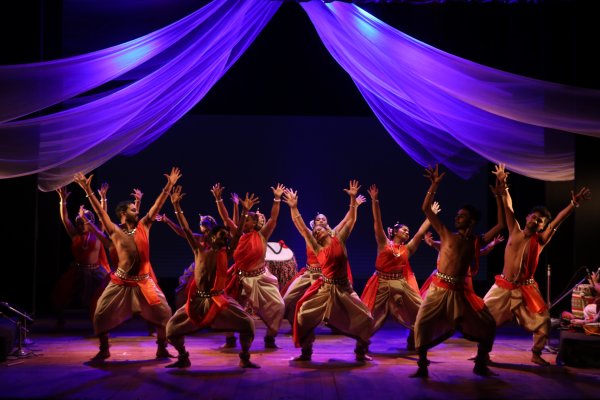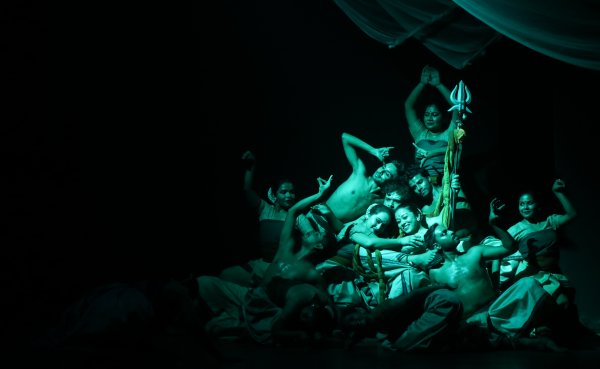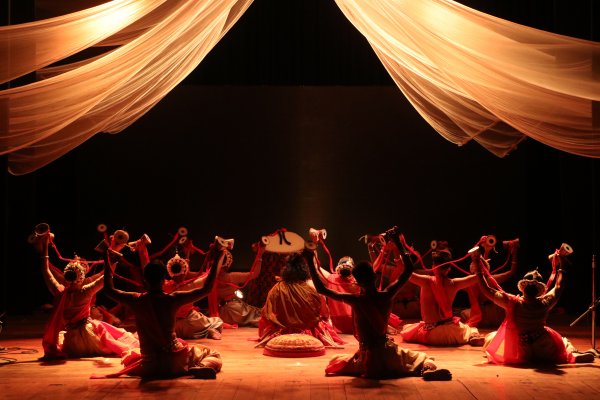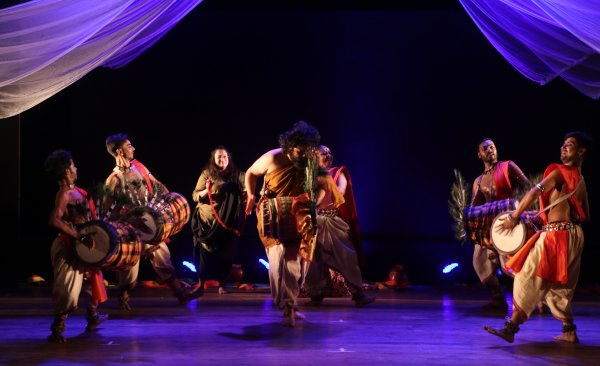
|   |

|   |
Murta Maheswara - Debolina Ghosh e-mail: debolina.2009@rediffmail.com April 11, 2025 Shiva - the endless emptiness of the unmanifested universe, consort of the manifested nature. He is omnipresent, all pervading through ancient and present, culture and religion, urban and rural, classical and folk. Shiva is easily satisfied, humoured, passionate and yet detached. He is rudra as well as shanta. Across cultures he is named as Marang Buru, Mahadev, Tunganath, Osiris, Carnunnos, Rudra and so many. He is called Bholanath who is innocent, Bhutnath who plays with ghost, Nataraja the cosmic dancer, Mahakal who is time himself. Shiva is truth that comes straight from the heart. It is the truth that is sought in Murta Maheswara. Shiva is the truth which is beauty, that beauty is truth again - "Satyam Shivam Sundaram." Guru Sharmila Biswas and Odissi dance, the art and the artiste have been unified by a long and tireless journey of passion and dedication. On 27th March at Gyan Manch of Kolkata, she gifted us a splendid evening of Odissi dance. Choreographed by Sharmila Biswas and performed by the dancers of OVM Repertory (Odissi Vision and Movement Centre), the program was Shivanjali in her own way - looking upon Shiva as Murta Maheswara. The show started perfectly on time. Lights went off. On the background screen of the stage, Shiva flashed up with commentaries and hymns. Suddenly we heard tinkling of ankle bells in the audience. A group of pilgrims moving with rhythm towards the stage and finally they stand in front of the stage, singing in praise of Shiva. They were all dancers of OVM. This was a brilliant choreographic idea which blurred the line between the lighted stage and dark audience seats. As if the dancers represented the rasikas and bearing the naivedya on behalf of the audience.  Shiva is described as Pashupati in the seals of Indus Valley Civilisation. His matted hair is the safe, cosy home of the birds and animals. Trees, birds, animals - the entire manifested nature is in perfect harmony under his divine love and protection. In his praise they all sing "Om Bhagavate Pashupataye Namaha". Shiva, the aranyak. The dense forest which is the birthplace of Vedas and all ancient wisdom was perfectly depicted on the stage through perfect postures and mudras of the dancers. Suddenly a fawn peeped left and right, full of curiosity and started prancing all over the stage with its agile and swift movement - what a brilliant start! Gradually, the stage was graced by all the mighty lives of the jungle. Heavy gajagati of an elephant, ferocious movements of a tiger, then the movements of arboreals, amphibians and reptiles were portrayed with immense energy. On the verge of danger when all the animals fight in unity to defy the fatal arrow of the hunter, they get strength from Shiva. At their utter helplessness, Shiva, the pashupati, comes and protects them. He is not only the lord of animals but also of the hunter. The predator and prey get united in his divinity.  Actually, he holds all the binaries as we see in his Nataraja figurine. On one hand he is playing damaru (the sound from which creation initiates) and on the other hand agni (fire that destructs everything). India is very rich culturally and that richness is prominent in Indian classical dance. All the animal movements and mudras are the product of intense and scientific observation of nature which is coded in Natyasastra. Rasikas of Kolkata are whole heartedly grateful to Guru Benimadhab Bedbaak (the Dand Ritualistic performers are led by him), who hails from Sonepur (Odisha), Dev Kumar Paul, Trilochana Mahato for guiding the performers in animal movement and mime. Life invigorates in all creation with the sound of damaru. Shiva is the player of damaru. He is the dhwani and the whole creation is his pratidhwani. Tinkling bells around his neck and waistbelt carry the mystery of rhythm. All atmas are perfectly synchronised with paramatma by thread of perfect, measured time - taalam - and the beats go Tat dhit tom nam / Dhit tai tom nam.  Laya is in our heart. As it beats, it keeps the laya (pace) of our body, our existence. And we humans, "amritasya putra" imitate these beats, this dhwani in our life, we create music and dance with rhythm. In this concluding part of Murta Maheswara, Sharmila Biswas showcased various musical instruments and explained how all these sounds are connecting them with the supreme one. It was indeed sangeet where geet, vadya and nritya all were integrated. Artistes on percussion, not only took the right side of the stage, they also shared the centre of the stage with the performers. In this context, we got the remarkable presence of Sannidhi Vaidyanathan on mridangam. Her skills made the program more colourful.  Joydeep Guhathakurata and Sreejan Chatterjee's music creation was really praiseworthy. Guru Dhaneswar Swain and Somnath Basu mesmerised us with their incredible work on rhythm. A big thanks to Bhavesh Modak for sound engineering, Saheb Sanyal for light, Soumitra Das and team for sound, Nandagopal Jana for sets and Niloy Sengupta for foyer decoration. Murta Maheswar was an excellent interweaving of concept, choreography and design. The talented dancers were Soumik Biswas (as Shiva), Raaginni Hindocha, Koushik Das, Dipjoy Sarkar, Biswajit Mondal, Pratap Roy (guest artist), Priya Manna, Adrija Debnath, Aindrila Panda, Sharanya Lall, Shriyaditya Banerjee, Sayantani Roy. The rehearsal director was Ayona Bhaduri. Sparsh Studio for Performing Arts has been consistently presenting Kolkata rasikas marvellous recitals on classical dance. Murta Maheswara was the first part of 'Story Tellers' which is a joint venture of both Sparsh Studio and Odissi Vision and Movement Centre (OVM). The story they told will remain engraved in our hearts.  Debolina Ghosh is an MPhil scholar, Department of Sociology, University of Burdwan, West Bengal. |